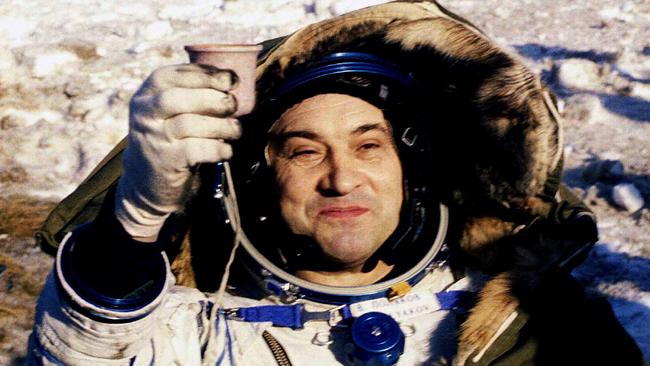Valeri Polyakov was off the planet and became world famous for it
All up, Valeri Polyakov spent almost two years in space, and if humans ever do go further than the moon, they’ll have him to thank.

OBITUARY
Valeri Polyakov. Cosmonaut.
Born Tula, Russia, April 27, 1942; died September 7, aged 80.
-
As he completed the 7000th orbit of his home planet on March 22, 1995 – his second trip to space – Valeri Polyakov might have considered the irony: he briefly would be one of the most famous people on Earth, by establishing the record for spending most time off it.
He spent a total of 22 months in the thermosphere in two stints to test the human capacity to live and work in a demanding, highly technical, microgravity environment. If Polyakov could remain physically well and work long periods with acuity then interplanetary exploration was possible.
Should humans one day venture beyond the moon, it will be because brave and brilliant people such as Polyakov risked not just space travel but long, lonely periods as guinea pigs in pods 350km above Earth while travelling round and around at 28,000km/h. Surely after 6999 circuits it becomes tedious, even if the rest of us would kill to do just one.
It had been a long trip from the city of Tula, the birthplace of Leo Tolstoy, about 200km south of Moscow. The day Polyakov was born there, Hitler’s invasion of Russia was under way and planning for what became the Battle of Stalingrad was well advanced.
Polyakov was four months old when his countrymen engaged in one of the greatest conflicts of mankind, a miscalculation by the Germans who lost, but only after both sides had registered one million casualties. Each, not collectively.
He was born Valeri Korshunov, changing his name when his mother remarried after his father died.
He attended local schools and performed well enough to land in a Moscow medical college. After graduating as a doctor he studied further and in 1964 committed himself to investigate space biology at the Institute of Biomedical Problems, a department of the Russian Academy of Science. Three years earlier, US president John Kennedy had vowed that an American would walk on the moon before the decade was out. In 1964, Soviet leader Nikita Khrushchev – who had overseen his country’s ambitious space plans – responded, announcing the Soviet Union would do the same. The space race was on, and the Russians were in front: they had been first to launch a man-made satellite, they landed a man-made object on the lunar surface, then they put a dog in orbit (she died), and then Yuri Gagarin (he lived). The Soviets achieved the first multiple crew flight, the first woman in space, the first space walk, and even flew by Mars.
History shows the Americans caught up quickly, about the time pushy Leonid Brezhnev ousted Khrushchev late in 1964 with his own October revolution ushering in years of scientific and social stagnation.
Polyakov played the long game and stayed on at the institute long after Apollo 11 trumped the Soviets. In 1971 they launched Salyut 1 – another first. Salyut (Russian for salute, and a tribute to Gagarin, who had been killed on a test flight three years before) was a modest craft, but it worked and tag teams spent weeks there at a time. The following year Polyakov began training as a doctor cosmonaut, along with a handful of others. The Apollo program consisted mostly of test pilots.
In the mid-1980s, with Brezhnev dead, the Soviet Union was up for another first, a modular space station that would be constructed by successive teams of cosmonauts. It was called Mir (Peace) and would be staffed by experts who could work on the complexities of travelling well beyond the moon, a trip that by then was clearly passe – no one has been since 1972.
Polyakov’s first space mission began on August 29, 1988, when he went to Mir with two others who, weeks later, returned to Earth, He stayed on for 240 days, twice being visited by other crews, the second of which brought him home.
He volunteered for another stay and took off for Mir on January 8, 1994, aged 51. This trip set the records that stand, including longest stay in space and a logbook that shows he travelled more than 300 million kilometres. Perhaps no man has gone further. If they ever do, it will be the result of the science Polyakov pioneered and the experiments to which he was subject.
Every heartbeat and mental pulse and mood was measured; his first weeks and last fortnight, during which he had to set up his compact digs and then prepare to return home after 437 days, were the hardest and he struggled with the workload.
He set out to prove humans could spend years in space. Shunning help when he landed in the Kazakhstan snow on March 23, 1995, he said: “We can fly to Mars!”




To join the conversation, please log in. Don't have an account? Register
Join the conversation, you are commenting as Logout